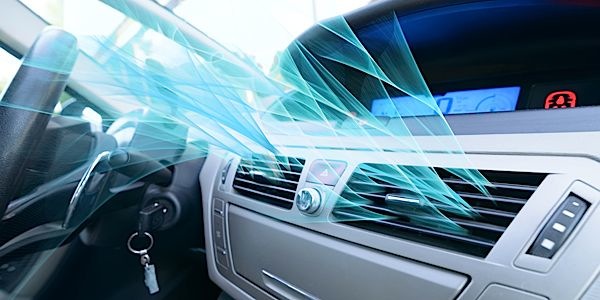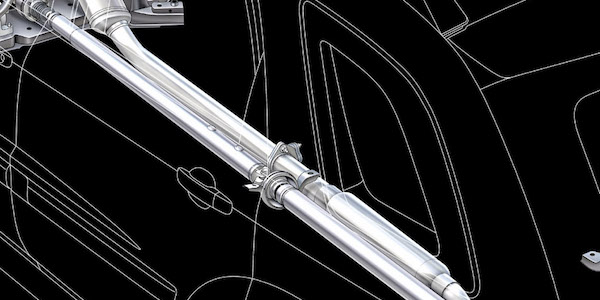
Accelerometers measure gravitational pull in gravitational force or G-force. Some cars will have one or two sensors depending on sophistication of the system. Some systems group the accelerometers in a sensor cluster. The typical sensor may cost $400 to $800.
Lateral/Transverse
These sensors are typically found under the center console near the vehicle’s center of gravity.
Your scan tool will read the sensor output in G-force or G. A typical road vehicle will be able to corner around one G. Single-seat race cars can corner at 4- to 5-Gs. Most production car accelerometers have a limit of 4-Gs.
Longitudinal
These sensors measure braking and acceleration. This can be used to determine how hard the driver is accelerating or braking. Longitudinal sensors can also be used to calculate the angle of the vehicle for hill holding.
It is very difficult and even dangerous to drive the vehicle and look at the readings from an accelerometer. You will see only minor movement in the sensor.
The best way to measure the performance of an accelerometer is to rotate it 90 degrees. When a lateral accelerometer is rotated 90º, it should read 1-G. When a longitudinal sensor is rotated on its end, it will read 1-G. This is because gravity is equal to 1-G.
Most accelerometers are wired with three wires. These include a 5-volt power, ground and signal wires. The signal wire will vary the voltage from 0-5-volts depending on G-force.
Sensor Replacement
Whenever an accelerometer is replaced, it must be recalibrated. Also, some sensors must be tightened in a specific procedure. A loose accelerometer can generate codes because it will be measuring vibration and not G-force.
YAW Sensors
A yaw sensor measures the vehicle’s rotation around its vertical axis, while at the same time measuring the acceleration at right angles to the driving direction.
By electronically evaluating the measured values, the sensor is able to differentiate between normal cornering and vehicle skidding movements. Yaw rate is measured in degrees per second. If you have a vehicles making a 90º turn in two seconds, it would have a yaw rate of 45º.
The Yaw rate sensor and accelerometers will often be mounted in a sensor cluster. To test a yaw rate sensor, rotate the unit so it is on a corner. The yaw sensor should react.
Auxiliary Water Pump Diagnostics
A car or truck comes into your shop with a complaint of poor heater performance. The driver complains that on cold mornings the heater will blow cold during the drive to work in rush hour traffic. The car is not overheating and the air is coming from the correct ducts. Your first reaction might be to install a new thermostat and inspect the heater core for a blockage. On the test drive, the system may perform great for you. Is the customer just cold blooded?
A car or truck comes into your shop with a complaint of poor heater performance. The driver complains that on cold mornings the heater will blow cold during the drive to work in rush hour traffic. The car is not overheating and the air is coming from the correct ducts.
VIDEO: Diagnosing The A/C Compressor Clutch
Andrew Markel discusses the clutch on the A/C compressor, and the signs to look for in your diagnostic to confirm its operation. Sponsored by Valeo.

Toyota FJ Cruiser Water Pump Replacement
Toyota’s original Land Cruiser was the company’s version of a Jeep that could go anywhere. In its time it was highly rated and collected, which led the Japanese juggernaut to bring back an updated SUV in 2007 called the FJ Cruiser. The retro-styled vehicle was again a go anywhere machine powered by a 4.0L V6 (1GR-FE) used in the Tacoma. The engines are durable and considered relatively robust for the time.

Long-Life Coolants Explained
Different types of coolants cover a range of applications from diesel to domestic, Asian and European vehicles. Each one is formulated to a specific manufacturer’s specifications to keep their engines at an optimal temperature. But, changes to the old one-size-fits-all formula has led to confusion for consumers and even some technicians.

VIDEO: Engine Efficiency Brings More Hoses
Andrew Markel discusses hoses and the necessity for several of them to route fluids to all parts of the vehicle due to the growing efficiency of engines. Sponsored by Dayco.

Other Posts
Why Does Engine Coolant Need Replacement?
Two specifications can be used to justify replacement — the condition of the additive package & the freezing point.

Bolster Your Steering and Suspension with Delphi!
A vehicle’s steering and suspension system is integral to its ride, handling, safety, and must always be up to the job–that’s where Delphi comes in. All Delphi chassis parts undergo rigorous dimension, material, durability, temperature, and performance tests to ensure they meet or exceed OE specifications at every turn. Because Delphi’s debut in steering and

Climate Control Modules
HVAC control modules may fail when the contacts and switches become inoperable. Sponsored by The Group Training Academy.

Improving Turbocharger Longevity
It is estimated that by 2022, 50% or more of vehicles sold in the U.S. will have one or more turbochargers under the hood.






